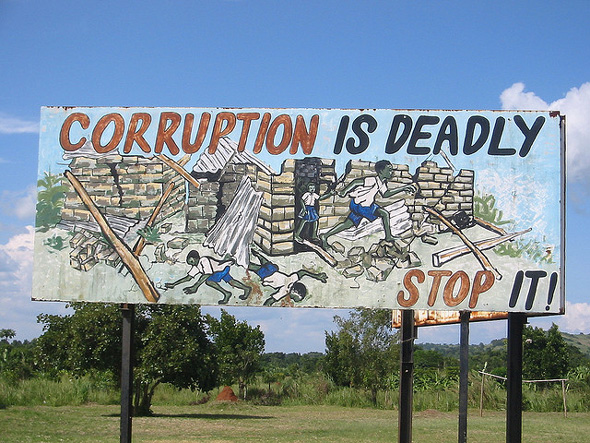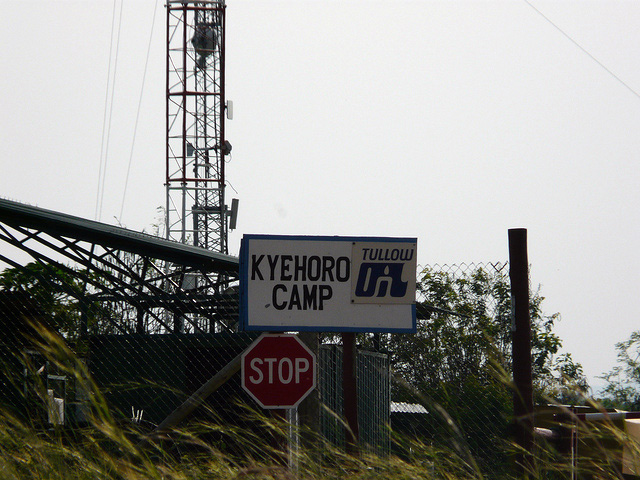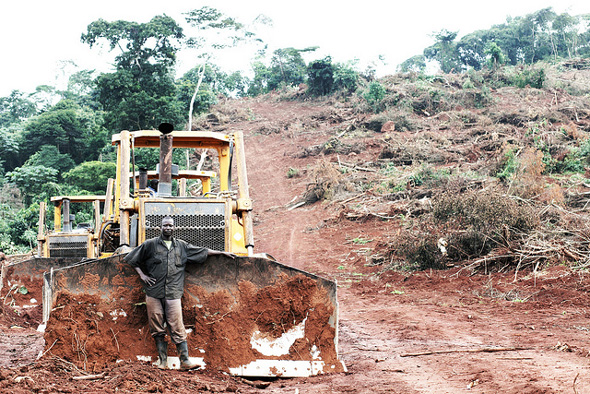-
Uganda’s Demographic and Health Challenges Put Into Perspective With Newfound Oil Discoveries [Part Two]
April 26, 2012 By Kate Diamond
“We never thought we would end up having the same problems here as the people in the Niger Delta. But now I’m worried,” Henry Ford Mirima, a spokesman for Uganda’s Bunyoro kingdom, said last fall in Le Monde Diplomatique. The kingdom – which calls itself East Africa’s oldest – sits along Lake Albert, where over the past seven years British oil company Tullow Oil has discovered oil reserves big enough to produce an estimated 2.5 billion barrels.
The discovery could make Uganda “one of sub-Saharan Africa’s top oil producers,” according to the U.S. State Department, and produce as much as $2 billion in annual oil revenues. Under the best of circumstances, that revenue would go towards addressing the country’s development hurdles, including population, health, and environment challenges. However, Uganda’s ability to peacefully and prosperously develop its natural resources will depend on the government’s ability to mitigate the corruption and inequities of recent years while navigating the security and environmental issues that continue to undercut the country’s stability.
The Displaced Legacy of Conflict
In 1986, as Yoweri Museveni and his National Resistance Army seized power from the government that succeeded President Idi Amin’s rule, Acholi rebels launched an uprising in Uganda’s north. Over the next few years, fighters led by Joseph Kony came to dominate the various splinter groups waging insurrection and, by the early 1990s, the Lord’s Resistance Army (LRA) had emerged to wage one of the world’s most brutal insurgencies. Throughout two decades of fighting, as much as 90 percent of northern Uganda’s population was displaced.
Uprooted Ugandans relocated to internally displaced person (IDP) camps, where conditions were so bad they have been described as akin to concentration camps. In 2005, amid worsening violence following a breakdown in ceasefire negotiations, the World Health Organization estimated that nearly 1,000 IDPs were dying every week in the Acholi sub-region.
International and domestic pressure forced the LRA base of operations out of Uganda by 2006, but its legacy remains. Looking at numbers alone, IDP reintegration would seem to be proceeding successfully: All but two percent of IDPs have left the camps, either returning to where they lived before the war or relocating to new areas. But the areas they move to tend to be underdeveloped and the government has been slow in implementing development plans to assist in reintegration. Combined, these factors mean that IDPs often end up in areas lacking basic services like healthcare, water, and education.
Growing Pressures on Finite Land
Land rights further complicate reintegration. In some cases, IDPs have returned to their homes only to find that entirely new generations of Ugandans have been born, grown up, and established themselves on their land. In other cases, they have relocated only for the government to evict them. Lacking a functional process for resolving land disputes, conflicts over who owns the land “often become violent,” according to a CSIS report.
The influx of refugees from the Democratic Republic of the Congo (DRC) adds another dimension to land disputes. In southwest Uganda, a flood of more than 1,000 Congolese refugees entering the country every week is outpacing the resources available to care for them – including space to house them. In the Kisoro district, which borders the DRC’s volatile North Kivu province, land disputes have become so severe that, in early March, the government sent troops to protect refugees from attacks by Ugandan squatters claiming land designated for camps.
Uganda’s rapidly growing population is putting further pressure on its land. With a total fertility rate of 6.8 children per woman and a growth rate of 3.2 percent, the predominantly rural population is expanding rapidly. As rural Ugandans search for larger and more productive tracts of land, they move farther into the country’s forests which, although protected, have effectively been opened up to migration following a 2006 executive order barring evictions from forest reserves and wetlands.
On average, Uganda’s forests are disappearing at a rate of about two percent per year, according to the government’s latest State of Environment report (2008). At subnational levels, though, deforestation varies wildly; for example, the once densely forested Kibaale district is leading the country at a rate of 49 percent per year, according to the report. On the whole, Uganda’s forests are disappearing so quickly that, by 2050, the country’s environmental management authority predicts that they will have disappeared entirely.
As deforestation continues, it is contributing to drought in some of the country’s most ecologically rich and agriculturally productive regions, which are now, for the first time in generations, experiencing food insecurity. Agricultural shortages have in turn contributed to spikes in food prices, which have been a key driver of the ongoing anti-Museveni protest movement.
Foreign investment, encouraged by Museveni, has in some instances aggravated land disputes. An Oxfam report suggests that the London-based New Forests Company, which purchased 27,000 hectares across three central districts in 2005, has driven more than 20,000 people from their land, sometimes violently. Ironically, the company bought the land to plant forests to be used as part of the Kyoto Protocol’s carbon credit-trading scheme. Friends of the Earth International, too, has made “land grabbing” the focus of a new report and advocacy campaign.
Adding Oil to the Mix
Access to land has become so contentious that disaster preparedness officials consider it a potentially destabilizing issue for Uganda’s future. The discovery of oil near Lake Albert magnifies the potential for instability in general and for land-driven conflict in particular. An estimated 30,000 people will be displaced to make way for an oil refinery, while those who remain have seen their livelihoods curtailed by violence between Ugandan Special Forces (led by Museveni’s son) and Congolese troops stationed on the lake’s shores. Given the lake’s location straddling the Uganda-DRC border, the government has warned that “there is the potential for any conflict to become regional.”
 Museveni has promised that oil revenue will go towards economic development, but given the regime’s growing dependence on political patronage as its popularity declines, observers are worried that Museveni will instead use Uganda’s oil wealth to strengthen his own hold on power.
Museveni has promised that oil revenue will go towards economic development, but given the regime’s growing dependence on political patronage as its popularity declines, observers are worried that Museveni will instead use Uganda’s oil wealth to strengthen his own hold on power.Lawmakers last year accused three ministers close to Museveni of taking bribes from Tullow, prompting a moratorium on further agreements with the company; however, Museveni has already violated the ban, signing a new production-sharing deal with Tullow earlier this year.
The potential for the misuse of oil revenues is all the greater given that the parliament has yet to establish regulations for the nascent industry. “Countries that start off from weak institutional capacity and poor governance prior to the discovery of oil or large mineral resources are likely to fall victim to the [resource] curse,” the Center for Global Development’s Alan Gelb and Stephanie Majerowicz wrote in a working paper on Uganda’s oil reserves last year. “Oil revenues are likely to exacerbate these institutional weaknesses, leading to greater corruption and poor overall governance.”
Looking at Uganda Through a PHE Lens
Properly managed, Uganda’s oil could propel its people “into the strata of middle-income countries,” but before that happens, the country’s population, health, and environment (PHE) challenges must be addressed. Recognizing the interconnectivity of many of Uganda’s most pressing challenges, several groups have already launched integrated development programs in the country.
Pathfinder International, an international reproductive health organization, recently announced plans for a new PHE program in the Lake Victoria basin that pairs health and family planning services with improved resource management. Like the rest of Uganda, the basin’s population is growing rapidly, straining the area’s natural resources. In the waters around Lake Victoria’s Migingo Island, for example, severe overfishing has provoked a border dispute with neighboring Kenya. By improving access to sexual and reproductive health services, Pathfinder says its work will strengthen sustainable resource management and preserve the region’s biodiversity. And that, in turn, could improve stability and security throughout the basin.
Conservation Through Public Health (CTPH), a Ugandan non-profit, aims to do the same in Uganda’s southwest, where some of the region’s most densely populated rural areas straddle Bwindi Impenetrable National Park, home to nearly half of the world’s endangered mountain gorillas and other valuable biodiversity. To sustain the health of both people and ecosystems, CTPH provides family planning and other health services to local communities while also monitoring the health of the gorilla population, which accounts for more than half of national tourism revenue. Minimizing pressures on the region’s fragile but valuable ecosystem helps protect livelihoods, which in turn can reduce the kind of competition over land that, compounded with refugees fleeing the DRC, has contributed to instability in the region.
On the Brink of a New Era?
Uganda, like Mozambique, Kenya, or Ghana, which also recently announced large oil and gas discoveries, may be on the brink of a new era in its economic development. But to enter that era, it must overcome significant demographic, health, environmental, security, and governance challenges.
Those challenges are large – but so too are the human and natural resources available to address them. Meeting unmet need for family planning, for instance, would not just open the door to near-term cost savings, but, when paired with continued investment in basic social services like education, could allow Uganda to realize a powerful demographic dividend. That dividend, coupled with more sustainable resource management, could in turn help overcome the hurdles that have so far limited its development.
Finding a way to ensure that Uganda’s newfound wealth responds to its complex needs will be crucial to ensuring that its already high levels of corruption and inequality are reversed rather than exacerbated, as has too often been the case for sub-Saharan Africa’s resource-rich nations.
Sources: Boston Globe, Brookings Institution, Center for Global Development, Center for Strategic and International Studies, Conservation Through Public Health, Department of Disaster Preparedness, Management and Refugees in the Office of the Prime Minister, Fox Business, Friends of the Earth International, Guardian, Le Monde Diplomatique, Monitoring and Evaluation to Assess and Use Results Demographic and Health Surveys (MEASURE DHS), New York Times, Oxfam International, Uganda National Environment Management Authority, United Nations Data, United States Department of State, World Bank, World Health Organization.
Photo Credit: “Tullow oil camp, Uganda,” courtesy of flickr user Conservation Concepts (Mark Jordahl); “Land grabbing in Uganda,” courtesy of Jason Taylor/Friends of the Earth International; “Ugandan anti-corruption sign,” courtesy of flickr user futureatlas.com; “Uganda GV6_lo,” courtesy of the International Center for Tropical Agriculture (CIAT).
 A Publication of the Stimson Center.
A Publication of the Stimson Center.






